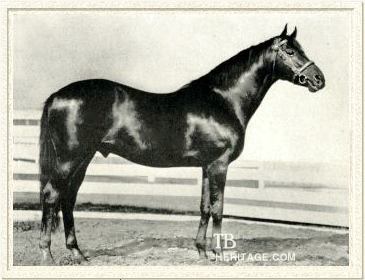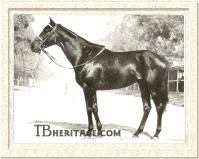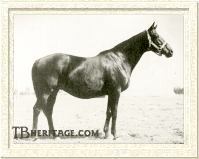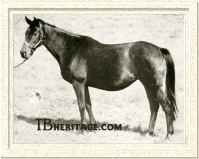|
|
Beau Pere

|
|
 |
|
|
While Beau Pere showed little class on the track, his superior pedigree proved itself time and again, making him a tremendously successful sire in three of the four countries where he stood at stud.
Beau Pere was bred in England by Sir John Jardine. He was sired by the great stayer and sire of stayers, Son-In-Law, and out of the 1,000 Guineas winner and Oaks second Cinna (by Polymelus), from a family of grand race mares extending back through Cinna's dam, Baroness La Fleche (by Ladas) to her granddam, the great La Fleche (by St. Simon).
Beau Pere, being a big, backward sort, was unraced at two. At three, he made seven starts, winning the Norfolk and Suffolk Handicap over a mile, his only victory that season. At four, he ran four times, wining twice, in the Swaffham Plate Handicap and Chesterfield Plate, both at one and three-quarter miles. He retired from racing with this undistinguished record of 11 starts, 3 wins, and earnings of only 974 pounds.
Beau Pere went through the auction ring that fall, bringing 700
guineas, the buyer being an agent for King George V. He stood for two
seasons in Newmarket in 1932 and 1933, although there was little demand
for his services, and he got only five English-bred foals as a result.
The horse was then offered at the 1933 December Sales, his pedigree
attracting a bid of 100 guineas on behalf of Mr. John Donald, owner of
Westmere Stud, located at Wanganui, New Zealand. Apparently Donald had
noted that the New Zealand sires' lst had been dominated for 11 straight
years by Foxbridge, by Foxlaw (by Son-In-Law).
In his new home in New Zealand, Beau Pere was a tremendous success with his first few crops, stamping his offspring in a very non-Son-In-Law fashion, getting a tremendous number of quick, precocious juveniles that made him as a top two-year-old sire. Fortunately, they also stretched out to the classic distances, winning the New Zealand Derby and Oaks. Beau Pere stood for three seasons in New Zealand and immediately jumped to top the sire list in the racing years 1938-39, and 1939-40 with the exploits of top runners like Beau Vite (1936), winner of the Great Northern Derby, St. Leger, and Auckland Cup; Beaulivre (1936), winner of the New Zealand Derby and Caulfield Cup; Beau Partir (1935), winner of the New Zealand St. Leger; and New Zealand Oaks winner Peerless (1935).
Westmere Stud was dispersed in 1937 due to Donald's failing health and
Beau Pere found a new owner when purchased for 3,300 guineas by
Australian W. J. Smith, who stood his prize at St. Aubins Stud, Scone,
New South Wales (Australia). There, the stallion's success continued
unabated, again becoming the leading sire, this time for three years running (1939-40, 1940-41, 1941-42), getting more top winners like Mayfowl (1940), Whisper Low (1938), Beau Cheval (1941), and another New Zealand Oaks winner in Belle Cane (1937), who later came to America.
The horse's dominance in the region prompted the importation of several of his siblings. His unraced half-brother Balloch (1939, by Obliterate) became the Leading Sire in New Zealand on two occasions, and an outstanding broodmare sire. His winning half-brother Mr. Standfast (1931, by Buchan) also became a leading sire in Australia and New Zealand. Even Dink (1934, by Nothing Venture) left a few useful daughters.
|

Honeymoon beat colts and older horses in California, later dam of Honeys Alibi.

Great Circle was a top runner in California | |
Beau Pere's record caught the eye of American movie magnate Louis B. Mayer, who purchased the son of Son-In-Law, along with several Australian-bred mares, to stand in California beginning with the 1941 season. The price was said to be $100,000. Arriving by ship in San Francisco on January 28, 1941, the stallion's success continued in America, beginning with the champion racemare Honeymoon (1943), and including top runners like Great Circle (1947), Bellesoeur (1945), Stepfather (1944), and Grandpere (1945). His forte in America seemed to be the precocious juvenile.
This success caught the attention of Kentuckian Leslie Combs II, who purchased the old horse from Mayer, syndicated, him, and had him shipped cross country to his new Kentucky home. Unfortunately, shortly after his arrival at Spendthrift Farm, Beau Pere colicked and died in
August of 1947.
Beau Pere's final record showed him as the sire of 49 stakes winners, 28 of which in Australia and New Zealand, and the remaining 21 sired in California.
|
Beau Pere was an imposing individual. He stood well over 17 hands and was broad as a bull, a physique with unusual consequences. When he arrived in Kentucky by train, he would not fit in the horse van and had to be walked the few miles out to Combs' Spendthrift Farm outside of Lexington. (One hopes this had nothing to do with his later demise.) Beau Pere was an unrefined individual with a thick neck, rather low withers (like his sire) and a long body. Photos also indicate that his pasterns were extremely upright.
Several of Beau Pere's sons proved to be top stallions including Beau Son, Beau Repaire, Beau Vite, Beau Cheval, and Beaulivre. In North America, only a few of his sons succeeded as sires, the very best of which was the non-winner Destino (1947), owned by King Ranch and later sent to Argentina. |

Bel Amour III, dam of top California handicapper Cover Up

Your Game, dam of Cyane and Your Alibhai | | Beau Pere's daughters proved tremendous broodmares, however. In Australia and New Zealand, they produced the likes of Karendi, Prince Morvi, Karachi, Putoko and numerous others. In America, they included Iron Reward (dam of Swaps, Like Magic, The Shoe, and Track Medal), Your Game (dam of Cyane, Your Alibhai), Flower Bed (dam of Flower Bowl, Brambles, granddam of Gallant Bloom, Graustark, and His Majesty), Honeymoon (dam of Honeys Alibi, Honeys Gem), Bellesoeur (dam of Beau Garm Jabneh, Vox Pop, Quillobelle, and Beau Diable, who stood in New Zealand with success), Judy-Rae (dam of Judy Rullah, Tulle, Princess Matoaka), Belle Cane (dam of Lurline B.), Belle Amour III (dam of Cover Up), Beauing (dam of El Drag), Distaff, Sybil, Feather Time, and Your Witness.
Many of Beau Pere's daughter's did well with the California sires Alibhai (who stood at Mayer's farm, and later stood at Combs' in Kentucky) and Khaled. The Alibhai/Beau Pere cross gave us Flower Bowl, Cover Up, Your Alibhai, Honeys Alibi (dam's sire of Dahlia), and Lurline B., while the Khaled/Beau Pere cross gave us Swaps, El Drag, and Candy Dish.
|
If Beau Pere's sireline is dwindling or dead, his daughters have ensured that his blood continues in the best of the breed.
--Anne Peters
|
|
|
|

